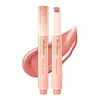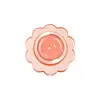What's inside
What's inside
 Key Ingredients
Key Ingredients

 Benefits
Benefits

 Concerns
Concerns

 Ingredients Side-by-side
Ingredients Side-by-side

Hydrogenated Polyisobutene
EmollientDipentaerythrityl Tetrahydroxystearate/Tetraisostearate
Skin ConditioningEthylhexyl Hydroxystearate
EmollientTridecyl Trimellitate
EmollientMethyl Hydrogenated Rosinate
PerfumingPhytosteryl/Isostearyl/Cetyl/Stearyl/Behenyl Dimer Dilinoleate
Skin ConditioningPropylene Glycol Dibenzoate
Skin ConditioningSynthetic Wax
AbrasiveDiisostearyl Malate
EmollientParaffin
PerfumingArgania Spinosa Kernel Oil
EmollientSimmondsia Chinensis Seed Oil
EmollientAcer Saccharum Extract
Skin ConditioningEuterpe Oleracea Fruit Extract
Fragaria Chiloensis Fruit Extract
Skin ConditioningLycium Chinense Fruit Extract
AntioxidantMorus Nigra Fruit Extract
Skin ConditioningRibes Nigrum Fruit Extract
AstringentRubus Fruticosus Fruit Extract
AstringentRubus Idaeus Fruit Extract
AstringentVaccinium Angustifolium Fruit Extract
Skin ProtectingVaccinium Macrocarpon Fruit Extract
AstringentVaccinium Myrtillus Fruit Extract
Skin ConditioningPhytosteryl Macadamiate
Skin ConditioningSilica Silylate
EmollientSorbitan Isostearate
EmulsifyingVp/Hexadecene Copolymer
Dextrin Palmitate
EmulsifyingMicrocrystalline Wax
Emulsion StabilisingPolyglyceryl-2 Triisostearate
EmulsifyingCera Microcristallina
Emulsion StabilisingPolyglyceryl-2 Diisostearate
EmulsifyingWater
Skin ConditioningButylene Glycol
HumectantEthylhexylglycerin
Skin ConditioningPhenoxyethanol
PreservativeCI 77891
Cosmetic ColorantCI 77491
Cosmetic ColorantCI 77492
Cosmetic ColorantCI 15850
Cosmetic ColorantCI 15985
Cosmetic ColorantCI 77499
Cosmetic ColorantHydrogenated Polyisobutene, Dipentaerythrityl Tetrahydroxystearate/Tetraisostearate, Ethylhexyl Hydroxystearate, Tridecyl Trimellitate, Methyl Hydrogenated Rosinate, Phytosteryl/Isostearyl/Cetyl/Stearyl/Behenyl Dimer Dilinoleate, Propylene Glycol Dibenzoate, Synthetic Wax, Diisostearyl Malate, Paraffin, Argania Spinosa Kernel Oil, Simmondsia Chinensis Seed Oil, Acer Saccharum Extract, Euterpe Oleracea Fruit Extract, Fragaria Chiloensis Fruit Extract, Lycium Chinense Fruit Extract, Morus Nigra Fruit Extract, Ribes Nigrum Fruit Extract, Rubus Fruticosus Fruit Extract, Rubus Idaeus Fruit Extract, Vaccinium Angustifolium Fruit Extract, Vaccinium Macrocarpon Fruit Extract, Vaccinium Myrtillus Fruit Extract, Phytosteryl Macadamiate, Silica Silylate, Sorbitan Isostearate, Vp/Hexadecene Copolymer, Dextrin Palmitate, Microcrystalline Wax, Polyglyceryl-2 Triisostearate, Cera Microcristallina, Polyglyceryl-2 Diisostearate, Water, Butylene Glycol, Ethylhexylglycerin, Phenoxyethanol, CI 77891, CI 77491, CI 77492, CI 15850, CI 15985, CI 77499
Water
Skin ConditioningDipentaerythrityl Hexahydroxystearate/Hexastearate/Hexarosinate
Skin ConditioningTriethylhexanoin
MaskingButylene Glycol
HumectantGlycerin
HumectantOctyldodecanol
EmollientPEG-240/Hdi Copolymer Bis-Decyltetradeceth-20 Ether
StabilisingPotassium Laurate
EmulsifyingTocopherol
AntioxidantPropanediol
SolventPolysorbate 60
EmulsifyingPhenoxyethanol
PreservativeEthylhexylglycerin
Skin Conditioning1,2-Hexanediol
Skin ConditioningCeteareth-20
CleansingHydroxyethyl Acrylate/Sodium Acryloyldimethyl Taurate Copolymer
Emulsion StabilisingSqualane
EmollientSorbitan Isostearate
EmulsifyingEthylcellulose
Glyceryl Caprylate
EmollientPolyglyceryl-2 Triisostearate
EmulsifyingCI 77891
Cosmetic ColorantDiisostearyl Malate
EmollientAcrylates/C10-30 Alkyl Acrylate Crosspolymer
Emulsion StabilisingTromethamine
BufferingParfum
MaskingTrisodium Ethylenediamine Disuccinate
CI 19140
Cosmetic ColorantCI 15985
Cosmetic ColorantCI 45410
Cosmetic ColorantCI 17200
Cosmetic ColorantPolyglyceryl-2 Diisostearate
EmulsifyingCI 42090
Cosmetic ColorantWater, Dipentaerythrityl Hexahydroxystearate/Hexastearate/Hexarosinate, Triethylhexanoin, Butylene Glycol, Glycerin, Octyldodecanol, PEG-240/Hdi Copolymer Bis-Decyltetradeceth-20 Ether, Potassium Laurate, Tocopherol, Propanediol, Polysorbate 60, Phenoxyethanol, Ethylhexylglycerin, 1,2-Hexanediol, Ceteareth-20, Hydroxyethyl Acrylate/Sodium Acryloyldimethyl Taurate Copolymer, Squalane, Sorbitan Isostearate, Ethylcellulose, Glyceryl Caprylate, Polyglyceryl-2 Triisostearate, CI 77891, Diisostearyl Malate, Acrylates/C10-30 Alkyl Acrylate Crosspolymer, Tromethamine, Parfum, Trisodium Ethylenediamine Disuccinate, CI 19140, CI 15985, CI 45410, CI 17200, Polyglyceryl-2 Diisostearate, CI 42090
Ingredients Explained
These ingredients are found in both products.
Ingredients higher up in an ingredient list are typically present in a larger amount.
Butylene Glycol (or BG) is used within cosmetic products for a few different reasons:
Overall, Butylene Glycol is a safe and well-rounded ingredient that works well with other ingredients.
Though this ingredient works well with most skin types, some people with sensitive skin may experience a reaction such as allergic rashes, closed comedones, or itchiness.
Learn more about Butylene GlycolCi 15985 is a dye made from petroleum. It is synthetically created and approved by the FDA for use in foods and cosmetics.
The color of this dye is orange/yellow.
This ingredient can be found in makeup, sun care, and skincare.
Learn more about CI 15985Ci 77891 is a white pigment from Titanium dioxide. It is naturally found in minerals such as rutile and ilmenite.
It's main function is to add a white color to cosmetics. It can also be mixed with other colors to create different shades.
Ci 77891 is commonly found in sunscreens due to its ability to block UV rays.
Learn more about CI 77891Diisostearyl Malate is an emollient and most often used in lip products. It comes from isostearyl alcohol, a fatty acid, and malic acid, an AHA.
As an emollient, Diisostearyl Malate helps create a thin film on your skin to trap moisture in. This helps keep your skin soft and smooth.
Ethylhexylglycerin (we can't pronounce this either) is commonly used as a preservative and skin softener. It is derived from glyceryl.
You might see Ethylhexylglycerin often paired with other preservatives such as phenoxyethanol. Ethylhexylglycerin has been found to increase the effectiveness of these other preservatives.
Phenoxyethanol is a preservative that has germicide, antimicrobial, and aromatic properties. Studies show that phenoxyethanol can prevent microbial growth. By itself, it has a scent that is similar to that of a rose.
It's often used in formulations along with Caprylyl Glycol to preserve the shelf life of products.
Polyglyceryl-2 Diisostearate isn't fungal acne safe.
This ingredient is a form of glycerin with emulsifying and emollient properties.
As an emulsifier, this ingredient helps keep products together while adding a thick texture. The manufacturer states this ingredient has emollient properties. Emollients help keep the skin hydrated by trapping moisture in.
Polyglyceryl-2 Triisostearate is created by reacting diglycerin and isostearic acid. Due to the isostearic acid base, it may not be safe for Malassezia or fungal acne.
Learn more about Polyglyceryl-2 TriisostearateSorbitan Isostearate is an emulsifer and cleaning agent. It is created from isostearic acid and sorbitol.
As an emulsifier, Sorbitan Isostearate prevents oils and water from separating.
Due to its isostearic acid base, it may not be safe for Malassezia or fungal acne.
Learn more about Sorbitan IsostearateWater. It's the most common cosmetic ingredient of all. You'll usually see it at the top of ingredient lists, meaning that it makes up the largest part of the product.
So why is it so popular? Water most often acts as a solvent - this means that it helps dissolve other ingredients into the formulation.
You'll also recognize water as that liquid we all need to stay alive. If you see this, drink a glass of water. Stay hydrated!
Learn more about Water